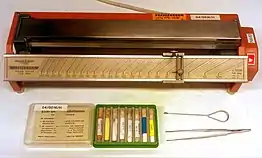Kofler bench
A Kofler bench, or Kofler heating bar; Kofler hot bar; Kofler hot bench, in German, Kofler-Heizbank,[1] is a metal strip with a temperature gradient (range room temperature to 300°C). Any substance can be placed on a section of the strip revealing its thermal behaviour at the temperature at that point.[2]

This melting-point apparatus for use with a microscope was developed by the Austrian pharmacognosist Ludwig Kofler (30 November 1891 Dornbirn - 23 August 1951 Innsbruck) and his wife mineralogist Adelheid Kofler. In 1936, the Koflers and Mayrhofer published their "Mikroskopische Methoden in der Mikrochemie" [Kofler, L., A. Kofler and Mayrhofer, A. (1936)], Kofler and Kofler published their "Thermomikromethoden" [Kofler L., and A. Kofler (1954)] in 1954.[3][4] The integration of microscope and Kofler bench is known as the Kofler hot stage microscope.[5]
Kofler, his wife Adelheid, and their colleague, Maria Kuhnert-Brandstätter, investigated numerous organic molecules, and published some 250 papers describing their work.[6]
Thermomicroscopy, incepted by Ludwig and Adelheid Kofler and developed further by Maria Kuhnert-Brandstätter (1919–2011) and Walter C. McCrone used the technique for studying the phases of solid drug substances.
See also
References
- Neuberg, Bill. "Kofler hot bench: repair of a class melting point determination apparatus". The McCrone Group.
- "Archived copy" (PDF). Archived from the original (PDF) on 2010-01-07. Retrieved 2010-09-18.CS1 maint: archived copy as title (link)
- "The Literature of Classical Microchemistry, Spot Tests, and Chemical Microscopy". 2006-02-26.
- History of Pharmacy
- Kumar, Arun; Singh, Pritam; Nanda, Arun (2020). "Hot stage microscopy and its applications in pharmaceutical characterization". Applied Microscopy. 50 (1). doi:10.1186/s42649-020-00032-9. ISSN 2287-4445. S2CID 219692412.
- http://pubs.acs.org/action/doSearch?action=search&searchText=Kofler&qsSearchArea=searchText&type=within&publication=40025988
Further reading
- Vitez, I (1998). "The evolution of hot-stage microscopy to aid solid-state characterizations of pharmaceutical solids". Thermochimica Acta. 324 (1–2): 187–196. doi:10.1016/S0040-6031(98)00535-8.